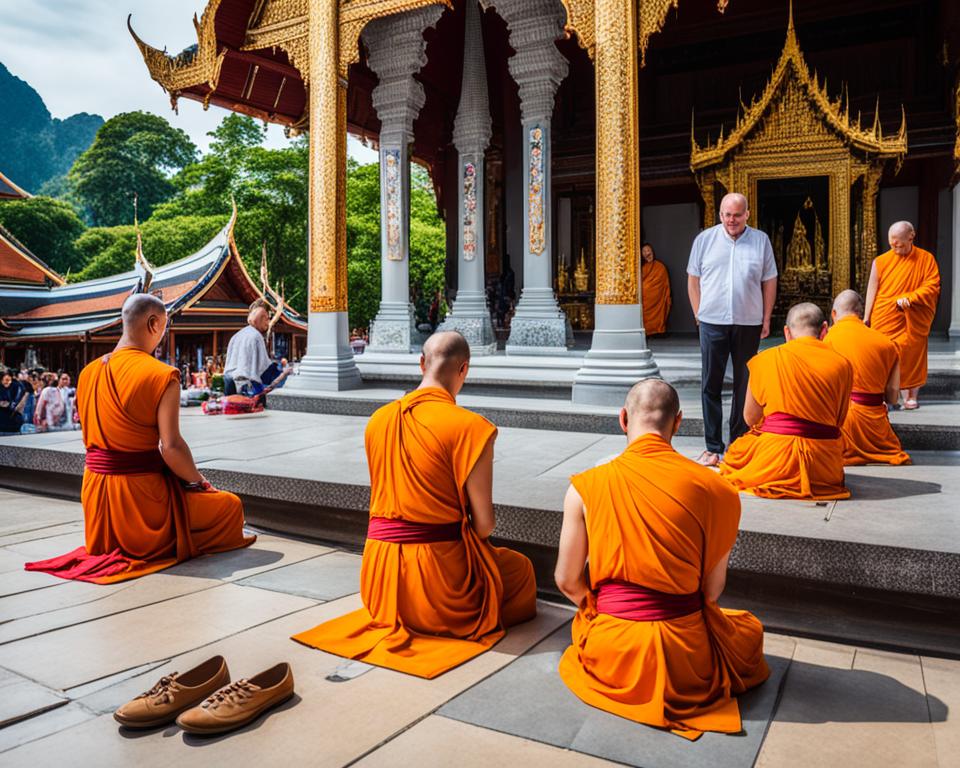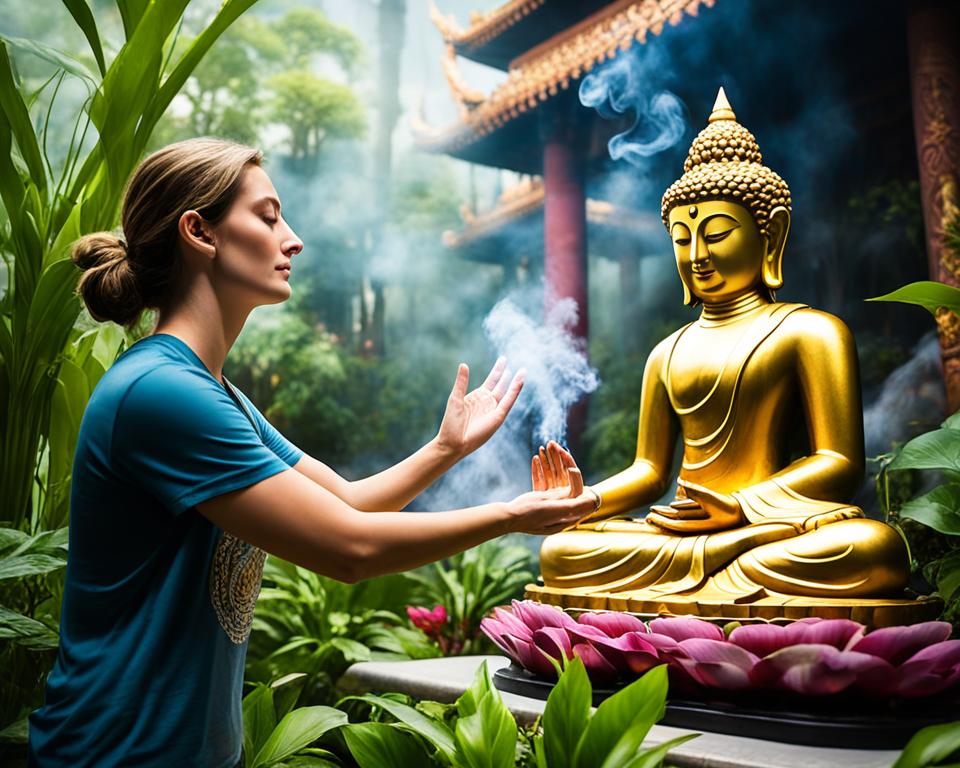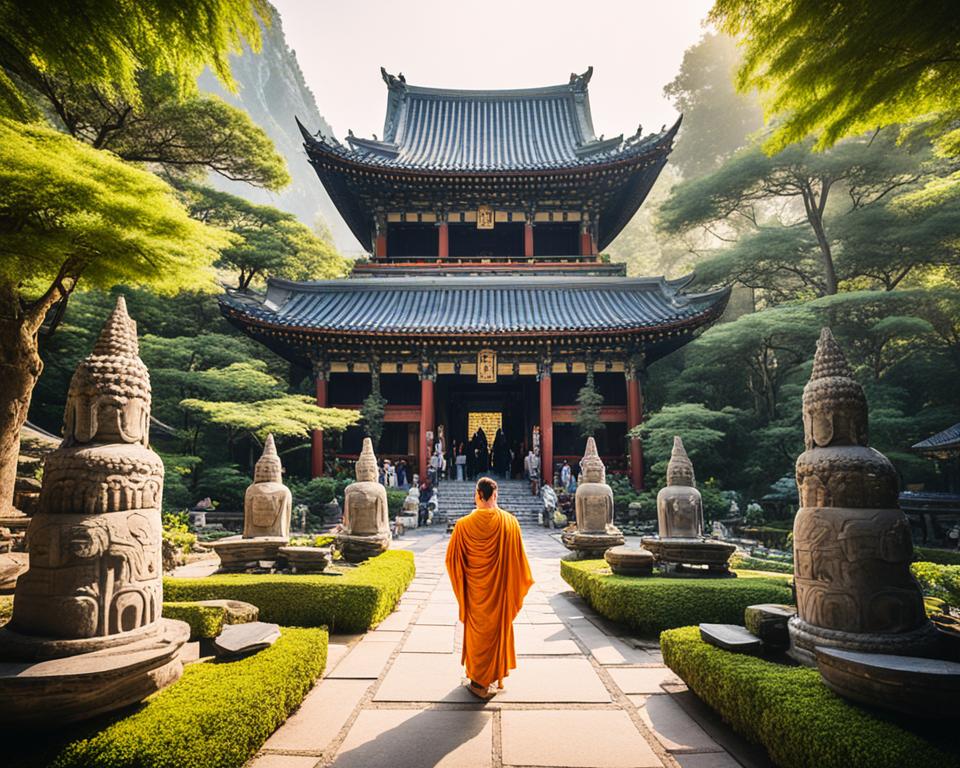Visiting temples in Thailand can be deeply meaningful. But, it’s important to follow the right dress code and etiquette. This way, you show respect for the sacred spaces. This article will guide you on the dos and don’ts, making your visit respectful and memorable.
Thailand’s temples are at the heart of its rich Buddhist culture. They are more than just places to visit. They are sacred grounds for worship, reflection, and preserving traditions.
Knowing how to dress and act at these holy sites is key. This guide tells you all you need to know to make a good impression. It’s time to learn the rules for visiting temples in Thailand, also known as the Land of Smiles.
When you visit Thailand, remember to respect its cultural traditions. Learn the dress code and the right way to behave. By doing this, you will have a more spiritual and wonderful experience at the temples.
Read more interesting information at ::zcr157602
Understanding the Significance of Thai Temples
Thai temples, or “wats,” go beyond stunning architecture. They are sacred places at the heart of thai temple customs. They play key roles in spiritual life, community, and culture. This makes them vital for understanding cultural sensitivity thailand temples.
Thailand’s Rich Buddhist Heritage
In Thailand, Buddhism isn’t just a religion—it’s at the core of the culture. Temples are community hubs, essential for social life and faith. They stand for spiritual growth, connections, and keeping old ways alive.
Temples as Sacred Spaces
- Temples, as sacred ground, bridge the gap between heaven and earth.
- They are homes to the Buddha and havens for monks and followers.
- Temple visits offer inner peace, moments for thought, and a stronger belief.
“Thai temples are not just places of worship, but repositories of the country’s rich cultural heritage and spiritual traditions.”
To truly experience Thai temples, visitors must approach them with deep respect. This approach is essential for respecting buddhist temples thailand and mindful temple visits thailand.
Appropriate Dress Code for Temple Visits
When you visit Thai temples, it’s vital to wear modest and respectful clothes. This means covering up in loose-fitting clothing. By dressing this way, you show respect for the temple’s importance and the beliefs it stands for.
Modest Clothing Guidelines
In Thai temples, cover your shoulders and knees with long pants or skirts. Wear shirts that cover your midriff too. This shows you understand the temple’s atmosphere and respect its customs. Since Thailand is often hot, choose clothes made of lightweight, airy materials.
Avoiding Revealing or Tight-Fitting Attire
Revealing or very tight clothes, like short shorts or sleeveless tops, should be avoided. Such clothes can be seen as disrespectful. Remember, aim for modesty to help maintain the solemnity of the temple.
| Appropriate Attire | Inappropriate Attire |
|---|---|
|
|
Following the modest dress code shows that you respect Thailand’s culture. It also honors the temple as part of that rich tradition.
“The way we dress when visiting a sacred space is a reflection of our respect for the culture and beliefs of the people who call that place home.”
Removing Shoes and Socks Before Entering
In Thailand, it’s normal and polite to take off your shoes and socks before you go into a temple. This helps keep the temple clean and holy because they believe shoes carry dirt. Before you step in, remember to take off your shoes.
Taking off your shoes and socks is a big part of showing respect at appropriate temple behavior in Thailand. It’s a way to show that you understand the temple is a special place. By removing our shoes, we show that we respect the temple and its spiritual meaning.
- Find the spot to take off your shoes before going to the temple.
- Sit down and gently take your shoes and socks off, putting them where they should go.
- Make sure your feet are clean before moving on.
- Go towards the temple carefully, moving slowly and being respectful.
Temples might have special rules or paths for visitors to use when they come in and leave. Make sure to look around and do what the temple says. This is a key part of showing respect for the Thai temple dos and don’ts.
| Proper Attire | Inappropriate Attire |
|---|---|
|
|
Showing respect by following the Thai temple dos and don’ts and taking off our shoes before entering is very important. This action of respect makes our visit richer and helps us feel the temple’s spiritual value more deeply.
Maintaining Respectful Behavior
When people visit Thai temples, showing respect is very important. It’s key to be careful of how we act. This helps keep the peaceful feel that surrounds these holy Buddhist places.
Silence and Serenity
Thai temples are for thinking quietly and finding your spiritual side. Visitors should talk softly. This way, they won’t break the calm. Respecting buddhist temples thailand means letting the temple’s natural sounds be heard, like meditation, soft leaves, and chanting.
Avoiding Public Displays of Affection
Showing love in a big way by hugging, kissing, or being overly touchy is not right at Thai temples. Appropriate temple behavior thailand says we should keep to ourselves. This shows respect and keeps the holy place’s peace.
- Speak softly and avoid loud noises or conversations
- Refrain from public displays of affection
- Observe the serene and contemplative nature of the temple
“Respect and reverence are the watchwords when visiting Thai temples. By maintaining a quiet, composed demeanor, you’ll not only honor the sanctity of these sacred spaces but also enhance your own experience of spiritual contemplation.”
Thai temple dos and don’ts help visitors blend in with the deep peacefulness of these special places. Following these rules shows your respect for Thai culture and its deep spiritual traditions.
Dos and Don’ts for Photography
Photography is usually allowed in Thai temples. But, there are guidelines to keep in mind. They are meant to show respect for the temple’s sacredness. Thai temple dos and don’ts highlight the need to behave well and show respect.
Respecting Sacred Areas
While taking pictures is okay, some places are too sacred. The inside part of the temples, where main Buddha statues sit, is one of these places. This area should not be photographed without permission. It’s to prevent any offense and keep the peace.
- Avoid taking photos of the inner sanctum or altars without permission.
- Be mindful of your surroundings and respect the sanctity of the space.
- Refrain from using flash photography, as it can be disruptive to the tranquil environment.
Following these steps allows for buddhist temples thailand to be respected. It also helps in keeping beautiful memories while understanding the rules.
“Treat the temples with respect and care, and you will be rewarded with a deeper understanding of Thailand’s rich cultural heritage.”
It’s vital to act correctly in temples, so they stay sacred. This creates a memorable visit for everyone.
rules for visiting temples in thailand
When you visit temples in Thailand, it’s more than a sightseeing trip. It’s a chance to dive into a rich culture. Remember to be respectful and follow the rules. This way, your journey will be as meaningful as it is fascinating.
Dress Code Considerations
Temple attire in Thailand is quite specific. You must dress modestly. That means no short clothes or bare shoulders. Choose outfits that cover you up. This shows you honor the spiritual place you’re visiting.
Removing Shoes and Socks
Before you step into a Thai temple, slip off your shoes and socks. It’s a sign of respect. Just watch out not to touch the temple with bare feet. That’s seen as rude.
Maintaining Quiet and Calm
Inside Thai temples, expect peace and quiet. Keep your voice down and your actions calm. This means no loud talking, laughing, or sudden noises. Show that you respect this as a place of devotion.
Respecting Sacred Areas
At temples, some spots are reserved for special use. Only go where you’re allowed. Avoid touching anything sacred without permission. And do not disturb the areas set aside for monks.
| Do’s | Don’ts |
|---|---|
|
|
Abide by the rules for visiting temples in Thailand and Thai temple dos and don’ts. Doing so will make your experience both respectful and insightful. It lets you connect with Thailand’s Buddhist traditions in a meaningful way.

Cultural Sensitivity and Respect
When visiting Thai temples, you need to understand the deep cultural and religious roots. It’s important to show cultural sensitivity and respect. Also, be ready to learn. If you follow the customs and manners, your visit will be richer. This way, you also respect the temple’s significance.
Appreciating Thai Traditions
Thai temples hold more than beautiful designs; they represent the country’s Buddhist heritage. It’s worth your time to know why these places are so important. This includes learning about the art, the meaning behind it, and the ceremonies held there. Understanding this will help you truly respect the local customs and traditions.
Mindful Temple Visits
- Be in a calm and contemplative state when you visit, and avoid being loud.
- Always dress modestly to show respect in the sacred space.
- Follow the temple’s rules, like taking off your shoes and knowing where not to go.
- Don’t take photos where it’s prohibited.
- Take time for quiet reflection and enjoy the temple’s peace.
By showing cultural sensitivity and respect, your visit to Buddhist temples in Thailand can be life-changing. A thoughtful visit helps everyone gain a deeper understanding and love for Thailand’s sacred places.
“The true reason for visiting a temple is not just seeing its beauty or taking pictures, but feeling the spiritual essence. It’s about understanding the depth of the culture.”
Visiting During Religious Ceremonies
In Thailand, you might come across sacred Buddhist ceremonies and festivals when exploring. These events show the deep spiritual traditions of the Thai people. They are often the highlight of any temple visit. It’s very important to show respect and be sensitive to others to truly enjoy and learn from these experiences.
Most Thai temples hold ceremonies that anyone can watch. This includes special days like the Thai New Year (Songkran) and Loy Krathong, as well as regular rituals. You’re welcome to be part of the audience, but remember not to disrupt the prayers and rituals with any loud or disrespectful behavior.
- Maintain a quiet and respectful demeanor during the ceremony, avoiding loud conversations or disruptive behavior.
- Refrain from interfering with the rituals or distracting the worshippers, as this can be considered disrespectful.
- Avoid walking in front of or standing directly in the line of sight of the participants, as this can be seen as intrusive.
- Respect the personal space and privacy of the individuals engaged in the ceremony, and avoid unnecessary physical contact.
By following the right temple behavior in Thailand and respecting Buddhist temples in Thailand, visitors can feel deeply moved and honored by these ceremonies.
“Approaching a Thai temple during a religious ceremony with reverence and sensitivity is a truly humbling and enlightening experience.”
These ceremonies are more than just shows. They are essential to the spiritual life of Thai people. By showing respect and understanding the importance of these events, visitors can experience the profound spiritual culture of Thailand. This helps in developing a deeper respect for Thailand’s Buddhist traditions.
Etiquette for Interacting with Monks
Understanding proper etiquette when visiting Buddhist temples in Thailand is crucial. The local society highly respects monks. Therefore, visitors should act with great respect and care when meeting them.
Appropriate Greetings
The right way to greet a Buddhist monk is through the Thai tradition called the “wai”. Place your hands together at your chest. Bow your head slightly while doing this. It shows honor and respect. Remember, never touch a monk; it’s seen as impolite.
Talking quietly and not looking directly at a monk is important. Be sure your feet are not pointed towards them. This is a sign of disrespect. Also, avoid being taller than the monk. Always keep your head lower than theirs.
- Greet monks with a traditional “wai” gesture
- Speak softly and avoid direct eye contact
- Sit or stand with your feet pointing away from the monk
- Never stand above a monk or place your head higher than theirs
By following these guidelines, visitors can honor the Buddhist faith. It makes temple visits respectful and deepens the experience. Embracing Thai cultural customs with the right attitude shows true respect for the local way of life.
“Respect and mindfulness are the keys to a meaningful interaction with Buddhist monks in Thailand.”
Offerings and Donations
When people visit Thai temples, they often give offerings or donate money. It’s a way to show respect and love. These actions are key in Thailand’s Buddhist culture and religion.
Traditional Practices
Typical gifts at Thai temples are flowers, incense, and candles. These items have special meanings. People place them in certain areas in the temple. This lets visitors join in with the temple’s sacred acts.
There are usually places to give money in the temple. Visitors can put any amount in the donation boxes or on the altars. This money helps keep the temples in good shape.
It’s vital to be careful when giving. Show that you understand and respect the Thai temple customs and Buddhist traditions, known as thai temple customs and respecting buddhist temples thailand.
Taking part in these customs is a great way for visitors to feel closer to Thailand’s Buddhist ways. Doing so with respect and care deepens their connection to the temples’ spiritual value.
Temple Tours and Guided Visits
Want a richer temple experience in Thailand? Join a guided tour or hire a local guide. They share fascinating facts on the temple’s past, its design, and the culture it holds. Plus, they help you know how to act with respect.
Guided visits make exploring temples easier and more meaningful. Local experts lead you through these holy places, deepening your understanding of Buddhism. This way, you get to appreciate Thai culture more.
- Local guides are like temple encyclopedias. They know everything from the design to the rituals. They tell stories and teach you about the temples’ history.
- Temple layouts can be tricky. Guides prevent you from getting lost and help you see all the must-visit spots.
- Connecting with a local guide lets you delve into the temples’ cultural and spiritual stories. This makes your visit more enriching.
- Guides show the do’s and don’ts to keep you from accidentally disrespecting the temple. They teach about what to wear and how to act.
| Benefits of Guided Temple Tours | Insights Gained |
|---|---|
| Comprehensive understanding of temple history and architecture | Appreciation for Thai Buddhist traditions and rituals |
| Guidance on proper etiquette and respectful behavior | Deeper cultural awareness and sensitivity |
| Seamless navigation of temple complexes | Enhanced mindfulness during temple visits |
Exploring Thailand with a mindful temple visits guide is special. It helps you truly connect with Thailand’s cultural sensitivity. This makes your journey memorable and deepens your experience.
Respecting Sacred Objects and Artifacts
When you visit Thai temples, it’s key to show respect for sacred objects there. Buddhist relics and holy items are very important to Thai people and their faith. It’s our duty as guests to treat these items with care.
At these temples, you’ll see beautiful sculptures, ancient statues, and artworks. These pieces hold a lot of cultural and religious value. So, avoid touching them without temple staff’s guidance.
- Admire the beauty and craftsmanship, but don’t touch.
- Observe the right way to act near these special items.
- Listen to temple staff or guides so you can respect the area.
Some temples also keep religious texts or books. These are as sacred as the objects. Always ask before you touch or move them.
“Respect the sacredness of the space and the objects within it. Your reverence will be appreciated by the Thai people and will contribute to a meaningful and enriching temple visit.”
Being respectful helps visitors enjoy the spiritual feel of Thai temples. It also lets them understand the deep Buddhist culture of the country. respecting buddhist temples thailand, appropriate temple behavior thailand

Conclusion
Visiting temples in Thailand is a profound cultural journey. It’s crucial to dress respectfully and respect the temple’s rules. This shows honor for these Buddhist sites.
It’s important to know how to act and what to wear at Thai temples. This includes dressing modestly, behaving courteously, and not taking photos in certain areas. By doing so, you respect the temple’s holiness.
A successful temple visit respects both cultural traditions and spiritual beliefs. It combines a thirst for learning with deep respect. This guide helps visitors have a positive temple experience.
